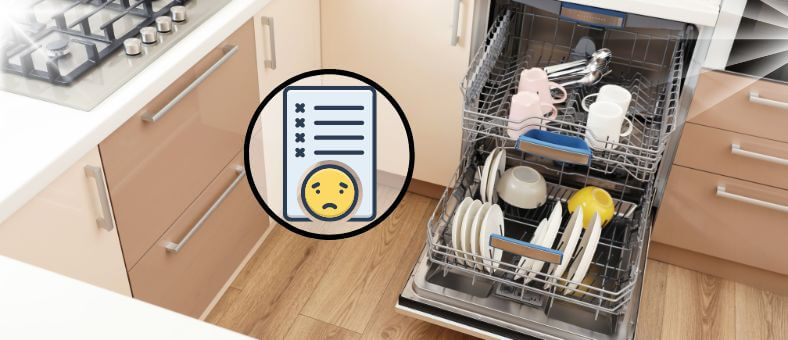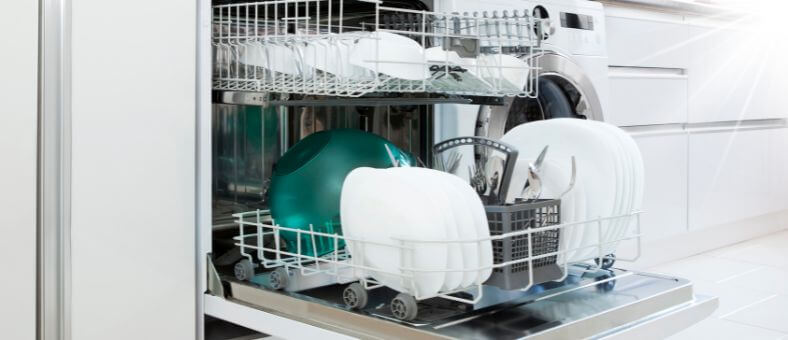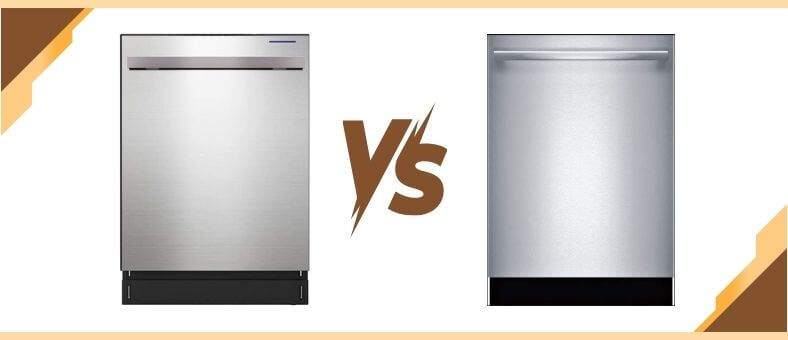Imagine this: a dishwasher that cleans your dishes and saves you time and money. Sounds dreamy, right? The truth is, your dishwasher holds the potential to offer all these benefits and more. However, many unknowingly commit a common dishwasher mistake (or several) that can dampen these advantages.
Sure, popping dishes into the machine and pushing a button seems straightforward. But like many things in life, the devil’s in the details. Some little habits or oversights might seem harmless but can mess with your dishwasher’s magic. Maybe it’s those pesky water spots on glasses or that fork that never seems to come out clean. These could all be signs you’re making some of these common blunders.
Lucky for you, we’ve rounded up 18 frequent slip-ups many of us make without even realizing it. And with each mistake we highlight, we offer easy fixes to set things right. The goal? To help you and your dishwasher live your best lives.
High Price of Common Mistakes
Shockingly, improper dishwasher cleaning and maintenance can increase repair or replacement costs by up to 50% over time.
Table of Contents
Understanding Your Dishwasher
Before we dive straight into the common dishwasher mistakes, let’s understand why they matter. Think of your dishwasher as a team member in your daily chore routine. This trusty machine works hard to ensure clean and hygienic dishes are ready for use. Like any other household appliance, it has its operating boundaries. Respecting these ensures efficiency and longevity.
Furthermore, understanding the basic principles of how a dishwasher works can help you use it more effectively. For instance, did you know How Much Water Do Dishwashers Use? These little insights matter, especially when you’re aiming for spotless dishes every single time. Or have you ever pondered, What is the best dishwasher detergent for your washing needs? The right choice can drastically enhance the machine’s cleaning efficiency. These little insights matter, especially when you’re aiming for spotless dishes every single time.
Are you ready to uncover the usual dishwasher blunders you might do daily? Let’s dive in!
Mistake #1: Cramming the Racks
We’ve all been there. A big dinner, lots of dishes, and you just want to fit everything in one go. But jamming dishes into every available space means they might need more thorough cleaning. Dishes need room to breathe (or, in this case, get washed!). A crowded dishwasher can leave you with spots, stains, and food residue on your plates. So, next time, resist the urge to overfill. Your dishes will thank you.
Mistake #2: Skipping the Pre-Wash Rinse
Your dishwasher is a champ, but it’s not a miracle worker. Leaving large bits of food on plates can clog up the system, and you might find the same bits stuck to your dishes after the wash. A quick rinse before loading can save you from rerunning a whole cycle. Plus, it helps keep your dishwasher cleaner and more efficient in the long run.
Mistake #3: Upward-facing Dishes Dilemma
Putting dishes facing upwards seems logical – more exposure to water, right? But this can lead to pooling and water spots. Sharp items like knives can be a safety hazard. Want to know how dishwashers affect the quality of your knives? Check out our detailed piece on The Dishwasher’s Impact on Knives. Meanwhile, angle your dishes slightly so water runs off, and always place sharp objects facing downwards for safety.
Mistake #4: Ignoring Hidden Cleaning Spots
Your dishwasher is a marvel, washing away stubborn food bits and grime from every crevice of your dishes. But have you ever thought about the nooks and crannies of the dishwasher itself? Over time, food particles, soap scum, and other residues can accumulate in often-overlooked areas like the door edges, rubber seals, and under the bottom rack. Ignoring these hidden spots can lead to odors, decreased performance, and a shorter lifespan for your appliance. So, next time you’re giving your kitchen a clean, spare a moment for these unsung areas of your dishwasher. A little attention can go a long way in keeping it running efficiently and smelling fresh.
Mistake #5: Upside-Down Cutlery Concerns
Loading forks and spoons facing down seems like the right thing to do, but when they’re facing up, there’s a higher chance they’ll “spoon” or stick together, leading to parts of them not getting clean. Plus, it can be safer to unload when sharp ends face down. So, mix it up and ensure your cutlery gets the clean they deserve.
Mistake #6: Detergent Dos and Don’ts

Detergent plays a pivotal role in getting your dishes spotless. However, more doesn’t always mean merrier. Overloading detergent can leave a soapy residue on dishes and reduce the efficiency of your dishwasher. On the other hand, too little might not get the job done. Stick to recommended amounts and opt for eco-friendly, gentle options on dishes and the environment.
Mistake #7: Delayed Door Opening Post-Wash
You hear the final beep, signaling the cycle’s end. But, if you’re not in a rush, it might be tempting to leave the door shut. However, doing so can trap humidity, leading to spots on glassware and fostering a moist environment perfect for unwanted mildew. To avoid this, slightly open the door once the cycle completes, letting fresh air in and steam out.
Mistake #8: Overlooking the Instruction Manual
“Oh, who needs an instruction manual for a dishwasher?” Many think this, but that little booklet can be a game-changer. Every model has its unique features and optimal loading patterns. Taking a few minutes to flip through the manual ensures you’re using the machine as efficiently as possible, and you might discover features you didn’t know existed!
Mistake #9: Washing Delicate & Wooden Wares
Your grandmother’s vintage china or that hand-carved wooden spoon might not appreciate the aggressive environment of a dishwasher. Delicate items can get chipped or their designs faded, while wooden items can warp and crack. It’s always best to hand-wash such items. Treat them with love, and they’ll last generations.
Mistake #10: Underutilizing Dishwasher Space
While it’s important to avoid cramming, underloading isn’t the way to go either. Running a half-empty dishwasher wastes water and energy. The trick is to find a balance. If you can’t fill it up by the end of the day, consider waiting until the next meal. But remember, waiting too long can lead to dried-up food residue, making cleaning tougher.
Mistake #11: Cold Water Start Mistakes
Starting your dishwasher with cold water can be a misstep many unknowingly commit. Dishwashers often require a warm start to effectively dissolve detergent and break down food particles. If the water is cold, the dishwasher works extra hard, extending the wash cycle and sometimes leaving dishes less than perfectly clean. To get the best results, ensure your water heater is set to a recommended temperature. Consider running the hot tap briefly before starting the dishwasher.
Mistake #12: Excessive ‘Eco’ Mode Dependency
Being eco-friendly is commendable, but relying solely on the ‘Eco’ mode isn’t always the best choice. This mode uses less water and energy, which is great for lightly soiled dishes. However, for those heavy-duty loads after a big meal, using a more intensive cycle ensures cleaner dishes. Diversify your settings based on your dish load!
Mistake #13: Obstructing the Spray Arm with Handles
The spray arm in your dishwasher needs a clear path to do its job properly. Placing long utensils or panhandles in its way can obstruct its rotation. This means some dishes might not get the full force of the water, leading to spots or food remnants. Always ensure that nothing is hindering the spray arm’s movement for the best wash.
Silent Sabotage
Many don’t realize that frequently blocking the spray arm can shorten its life. This means you might have to replace it twice as often!
Mistake #14: Sticking to a Single Setting
Dishwashers come with various settings for a reason. While you might have a favorite or go-to mode, repeatedly using the same setting might not yield the best results. Some loads might need a quicker wash, others a more intensive one. Experiment with different settings to find out what works best for different loads. If you’re unsure about which cycle or settings to use, our article Dishwasher Cycles and Settings Explained can be a handy guide.
Mistake #15: Emptying Top Shelf Ahead of Time
It seems logical to start unloading the top shelf first, but this can lead to water dripping from the bottom rack onto your sparkling clean dishes above. Instead, start with the bottom rack to ensure any residual water doesn’t spoil the cleanliness of your top-shelf items.
Mistake #16: Disorderly Dish Stacking
Think of your dishwasher as a game of Tetris – every piece (or dish) should have its perfect spot. When dishes are thrown in without order, they might block each other, leading to unsatisfactory cleaning results. Plates should stand in neat rows, pots and pans angled downward, and bowls strategically positioned so water flows freely. Remember, a well-organized dishwasher isn’t just pleasing to the eye; it guarantees cleaner dishes!
Mistake #17: Dishwasher Overstuffing
We’ve all been there: trying to fit in that last bowl or cup, thinking it saves time and water. However, overcrowding is a prevalent dishwasher mistake, preventing water and detergent from circulating freely. Some dishes might not get cleaned properly, leading you to run another cycle. It’s wise to wait for a full load rather than overstuffing. For those keen on optimizing space and ensuring an impeccable wash, understanding how to load your dishwasher properly can be a game-changer. Let your appliance excel in what it does best!
Mistake #18: Infrequent Dishwasher Use
While running the dishwasher only when full is a smart move, letting it sit idle for extended periods can invite unwelcome smells and even mold. Ever pondered, What Is The Best Time Of Day To Run Your Dishwasher? Well, running it daily, regardless of the time, helps maintain its cleanliness and keeps odors at bay. If you’re light on dishes, consider utilizing the rinse cycle between full washes, ensuring everything remains fresh and primed for action.
Three Top Tips for Using Your Dishwasher
Ah, dishwashers – the unsung heroes of our modern kitchens. While they make our lives considerably easier, there are a few golden rules to ensure their longevity and efficiency. Here are the top three:
Load Correctly
Ensuring the proper placement of dishes can make a world of difference. Avoid overcrowding, and ensure that dishes aren’t overlapping, which can prevent proper cleaning.
Use the Right Detergent
The market is flooded with various detergent types: powders, liquids, gel packs, and trending dishwasher pods. While choice is great, it’s essential to recognize that not all detergents deliver the same performance. Using an incompatible or low-quality type can result in residues or inadequate cleaning. Always opt for a high-quality detergent that is harmonious with your dishwasher’s specifications. If you’re gravitating towards the convenience of dishwasher pods but need clarification on their application, delve into How To Use Dishwasher Pods to maximize their potential.
Routine Maintenance
A dishwasher thrives with a little TLC like any appliance. Regularly clean the filter, check the spray arms, and run an occasional empty cycle with a cup of white vinegar to keep it running smoothly. And if you’ve ever been greeted by an unpleasant odor when opening your dishwasher door, you might benefit from learning How to Clean a Smelly Dishwasher to ensure a fresh-smelling machine every time.
Items to Think Twice About Washing in Your Dishwasher
Absolutely! While dishwashers are robust, certain items don’t fare well inside. Here are a few to consider:
Wooden Items
Wooden spoons or bowls can warp and crack.
Cast Iron or Non-Stick Pans
These can lose their finish and rust.
Sharp Knives
Using a dishwasher for your best knives can dull them prematurely. Consider investing in a set designed to remain sharp and intact, even with frequent washing.
Crystal or Hand-Painted Items
The intense heat and strong detergents can damage them.
What Might Damage Your Dishwasher?
The dishwasher might seem invincible, but certain mistakes can cut its life tragically short:
Hard Water
Hard water is more than just tough on your taps; it’s challenging for your dishwasher, too. The mineral buildup from hard water can gradually damage your machine, affecting its efficiency and potentially causing malfunctions. Using water softeners can significantly help in mitigating this issue. Hard water might be the culprit if you’ve noticed spots on your dishes or a filmy residue. Consider using a water softener or specialized detergent to counteract the effects. Additionally, be mindful of the potential dishwasher problems caused by hard water and stay proactive in your machine’s maintenance.
Large Food Particles
Modern dishwashers are beasts, but large chunks of leftover food can clog the drain or harm the spray arm.
Broken Glass
Tiny shards can get lodged in the machinery, causing potential damage.
Using Regular Dish Soap
This can cause oversudsing and lead to potential leaks or other issues.
Wrapping It Up: Common Dishwasher Mistakes
Who knew that a simple kitchen appliance could have so many nuances? Now that we’ve navigated through the common pitfalls, it’s time to let your dishwasher shine (and your dishes, too!). By sidestepping these common dishwasher mistakes, you’re not only ensuring cleaner dishes but also extending the lifespan of your trusty machine. So, the next time you load up those plates and utensils, take a moment to remember these tips. After all, a little care goes a long way in making chores smoother and easier. Cheers to squeaky-clean dishes every time!
At WashDryDazzle, we’re dedicated to providing essential insights that make your daily chores effortless. Dive deeper into our comprehensive Dishwasher Education hub to learn more.
The Health Benefits of Using a Dishwasher: Why It’s More Than Just Convenient

Sure, the convenience of loading up dirty plates and getting them out spotless is amazing. But the benefits of using a dishwasher go beyond that. Did you know that these kitchen heroes can also be a secret weapon for your health? They fight off germs and bacteria with high-temperature washes, ensuring your dishes aren’t just clean but sanitized. Plus, they tackle allergens and mold that manual washing might cause.
More than just a time-saver, a dishwasher contributes to a healthier kitchen environment. Dive in with us to uncover the added health perks this gadget offers. Ready to give your dishwasher the appreciation it truly deserves? Let’s go!
The Invisible Threat
Did you realize? Dishes that look clean can still harbor up to 1 million bacteria if not properly washed!
High-Temperature Cleaning Eliminating Harmful Bacteria
If you’ve ever wondered why dishes feel so warm after a dishwasher cycle, it’s all thanks to the high temperatures. Your dishwasher isn’t just splashing water around; it’s employing hot water that effectively kills many bacteria and pathogens. Hand washing, even with warm water from the tap, rarely reaches the temperatures that dishwashers achieve. While hand washing might eliminate visible food bits, it might not do much against those invisible, pesky germs. With a dishwasher, you’re not just cleaning—you’re sanitizing.
Say No to Mold: Dry-Cycle Benefits
We’ve all been there—dishes left to air dry, only to later find a musty smell or mold spots. Mold loves moisture, and dishes left out are an open invitation. Enter the dishwasher’s drying cycle. It reduces the moisture content, making it tough for mold to thrive. Unlike manual drying, which can sometimes miss nooks and crannies, a dishwasher’s dry cycle ensures dishes are thoroughly dried, reducing the chances of mold and ensuring your plates are ready to use anytime. Learn How to Remove and Prevent Mold in Your Dishwasher to address and prevent such issues.
Reduced Physical Strain Caring for Your Hands and Back
Using a dishwasher isn’t just about convenience; it’s also about health. The repeated actions of scrubbing dishes, rinsing, and bending over a sink can strain your back and wrists over time. Not to mention the pruney fingers! With a dishwasher, you reduce the physical labor, giving your back and hands a much-needed rest. Remember, it’s not just about saving time but also about taking care of your well-being.
Avoiding Chemical Residue: Rinse Cycles to the Rescue
Have you ever washed dishes and later found them feeling a bit slippery? That could be residue from dish soap or detergent. Even tiny amounts of these residues can be ingested over time. Thankfully, dishwashers have specialized rinse cycles to ensure every last bit of detergent is washed away, leaving your dishes sparkling clean and free from unwanted chemicals.
Less Room for Human Error: Consistent Cleaning Every Time
Ever washed a dish by hand, only to later discover a missed spot? It’s a common error that could mean bacteria is still lingering. Dishwashers, on the other hand, are designed for consistency. Their pre-set wash cycles and vigorous water jets ensure all areas of your dishes get the attention they deserve. No corner or crevice goes untouched, which means fewer chances of improperly cleaned dishes harboring unwanted microbes. So, when you unload a dishwasher, you’re not just getting clean dishes—you’re getting consistently clean dishes every time.
Protecting Against Allergens: Deep Cleaning Benefits
Even minor allergen traces on dishes can trigger reactions in those with allergies or sensitivities. Dishwashers can be a boon in such situations. Their high temperatures and thorough cleaning mechanisms are more effective at breaking down and removing allergens than manual washing. Be it residue from nuts, dairy, gluten, or other common allergens, the dishwasher ensures your dishes aren’t just clean and safe for everyone to use. In a world of rising allergies, using a dishwasher isn’t just a luxury—it’s a protective measure.
Limiting Cross-Contamination: Separate and Safe Washing
In the culinary world, cross-contamination is a real concern. Imagine using the same plate for raw meat and then for fresh vegetables without a proper wash in between—it’s a recipe for disaster! With a dishwasher, you can strategically load dishes to avoid this. Plates that hold raw meat can be placed separately from those with other foods, ensuring each dish gets thoroughly cleaned without risk of cross-contamination. The intense cleaning process also means any potential pathogens from raw food residues are effectively killed. This systematic approach ensures that every dish from the machine is clean and safe.
Soap and Detergent Safety: Using the Right Amount
Have you ever wondered if you use too much or too little detergent while hand-washing dishes? Or pondered about trying a homemade dishwasher detergent but needed to figure out the quantity? With a dishwasher, these uncertainties are put to rest. Most modern dishwashers have automatic detergent dispensers that gauge the right amount for each wash cycle. This ensures that whether you’re using commercial or homemade dishwasher detergent, your dishes are cleaned effectively with reduced chances of any chemical residue remaining. Such precision guarantees spotlessly clean dishes and ensures a safer dining experience, protecting you from unintentionally ingesting any residual detergents.
Dishwashers and Indoor Air Quality: Less Damp, Less Worry
A damp environment can lead to various home issues, including mold and mildew growth. Hand-washing dishes can inadvertently contribute to this, especially if you habitually let dishes air dry on a rack. On the other hand, dishwashers significantly reduce indoor humidity with their dry cycles. Removing excess moisture from dishes and releasing it safely, dishwashers help maintain better indoor air quality. Less moisture means less chance for mold spores to proliferate. So, with a dishwasher, you’re ensuring clean dishes and a healthier living environment.
A Champion for Health in Disguise
When we consider a dishwasher, we often think of mere convenience. But diving deeper into its benefits reveals a guardian of our health. From eliminating harmful bacteria with high-temperature cleaning to preventing mold and ensuring consistent sanitation, its role is crucial.
It’s not just about sparkling dishes but also about a safer, more hygienic living environment. As you load your dishwasher next, recognize its contribution to a healthier home. Beyond convenience, it’s an essential ally in our pursuit of well-being.







